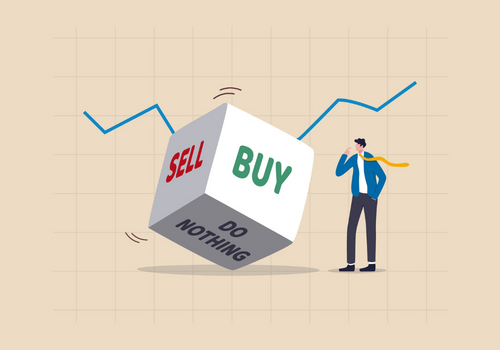Forex market: exploring the world of foreign exchange trading

Welcome to the exciting world of forex trading! If you're reading this, you're likely interested in learning about the largest financial market in the world - the foreign exchange, or forex, market. With an average daily trading volume of over $5 trillion, the forex market offers endless opportunities for traders of all levels to profit from the fluctuations in currency prices.
Whether you're a complete beginner or have some trading experience, this beginner's guide to currency trading will provide you with a comprehensive introduction to the basics of forex trading.
We'll cover everything from the mechanics of forex trading, including how forex markets work to indicators that one should look for when trading so as to succeed in this dynamic market. With a little bit of knowledge and a lot of practice, you can potentially develop strong trading strategies and become a successful forex trader.
What is Forex trading (FX)?
FX or Forex is a commonly used abbreviation for the foreign exchange market. It refers to the global decentralized market where individuals, institutions, and governments trade currencies with each other. In simple terms, Forex is the market where you can buy one currency and sell another at the same time, based on the fluctuations in the exchange rates between them.
How does the Forex market work?
Have you ever wondered how Forex trading works? Well, it's all about currency values and price quotes. A currency's value is determined by how much of another currency it can purchase, which is represented by a price quote.
Every price quote includes two prices, a bid price and an ask price. The ask price is used when buying a currency, while the bid price is used when selling.

It's important to note that the ask price is always higher than the bid price. Therefore, when you sell your currency to a bank, they will buy it at a lower price and sell it back to you at a higher price. In Forex trading, the difference between the bid and ask price is called the spread.
Forex trading can seem daunting at first, but it’s actually not that complicated. Market participants can instantly communicate bid and ask prices, except when the market is closed. Traders receive price quotes from their brokerage firm, which obtains them from liquidity providers like banks.

When there's plenty of liquidity, the spread tends to be tighter. However, during major news releases, rapid price shifts can create price gaps.
Trading Forex is a click away on a trader's chosen platform. A buy order, for example, uses a portion of a trader's account to purchase the base currency, such as the Euro, while selling the quoted currency, like the US dollar.
This is known as a buy order, and it can be placed with the broker or communicated directly to the Forex interbank market.

It's also important to note that a trader can sell a currency they don't own in a process called "selling short" or "short selling". In short selling, the trader borrows the currency they want to sell from a broker or another party, sells it on the market, and hopes to buy it back at a lower price in the future to make a profit. The trader would then return the borrowed currency to the lender.
Short selling can be a high-risk strategy because if the price of the currency rises instead of falls, the trader will have to buy it back at a higher price than they sold it for, resulting in a loss. Additionally, the lender may demand the borrowed currency back at any time, which can cause the short seller to have to buy it back at a potentially unfavorable price.
Buying and selling in Forex may seem confusing, but it's important to understand that each trade involves exchanging one currency for another. A beginner may find it helpful to view currency pairs as an abstract financial instrument assigned a price by the market.
Forex trading is practiced worldwide, and its basics remain the same regardless of location. While regulations may differ, the underlying structure and key players of the market are the same. By understanding the fundamentals, traders can approach Forex trading with confidence and success.
For more information about FX trading, check out the related articles on our blog
Which currency pairs are the most commonly traded in the Forex market?
The most traded currency pairs in the Forex market are known as the "majors" and they include:
- EUR/USD (Euro/US Dollar)
- USD/JPY (US Dollar/Japanese Yen)
- GBP/USD (Great British Pound/US Dollar)
- USD/CHF (US Dollar/Swiss Franc)
- AUD/USD (Australian Dollar/US Dollar)
- USD/CAD (US Dollar/Canadian Dollar)
- NZD/USD (New Zealand Dollar/US Dollar)
These pairs represent the currencies of some of the world's largest and most influential economies, including the United States, the European Union, Japan, the United Kingdom, Canada, Australia, and New Zealand. They are highly liquid and offer traders plenty of opportunities to make profitable trades.
Factors that affect the Forex market
There are many factors that can affect the Forex market, including:
- Economic indicators
- Economic data releases such as GDP, inflation, employment, and interest rates can significantly impact currency prices.
- Political events
- Changes in government or policy, elections, and geopolitical tensions can all affect currency markets.
- Central bank policies
- Monetary policies and interest rate decisions by central banks such as the Federal Reserve, European Central Bank, and Bank of Japan can impact currency prices.
- Market sentiment
- The overall mood of investors and traders can impact currency prices, especially during times of uncertainty or high volatility.
- Natural disasters
- Natural disasters such as earthquakes, hurricanes, and floods can disrupt trade and impact currency prices.
- International trade
- Trade agreements, tariffs, and import/export levels can impact currency prices.
- Market speculation
- The actions of large traders and speculators can impact currency prices, especially in the short term.
- Global events
- Wars, terrorist attacks, and other major events can cause volatility in currency markets.
- Market liquidity
- The availability of buyers and sellers in the market can impact currency prices, especially for less liquid currencies.
- Technological advancements
- Advances in trading technology and the use of algorithms and artificial intelligence can impact currency markets.
Capitalise on volatility in Forex markets
Take a position on moving Forex prices. Never miss an opportunity.

Indicators to consider when trading Forex
Traders should look at a variety of indicators when trading forex, depending on their trading strategy and goals. Here are some of the most common indicators used in forex trading:
- Moving Averages (MA)
- A moving average is a line that shows the average price of a currency pair over a specific period of time. Traders use MAs to identify trends and potential support/resistance levels.
- Relative Strength Index (RSI)
- The RSI is a momentum indicator that measures whether a currency pair is overbought or oversold. Traders use the RSI to identify potential reversals in price.
- Bollinger Bands
- Bollinger Bands are a volatility indicator that show the high and low of a currency pair over a specific period of time. Traders use Bollinger Bands to identify potential breakouts and to determine when a currency pair is overbought or oversold.
- Fibonacci Retracement
- Fibonacci retracement levels are horizontal lines that indicate where support and resistance are likely to occur based on the Fibonacci ratio. Traders use these levels to identify potential entry and exit points.
- The Moving Average Convergence Divergence (MACD)
- The MACD is a trend-following momentum indicator that shows the relationship between two moving averages. Traders use the MACD to identify potential trend reversals and to confirm trend direction.
- Candlestick Patterns
- Candlestick patterns are visual representations of price movements that show the opening, closing, high, and low of a currency pair over a specific period of time. Traders use these patterns to identify potential trend reversals and to confirm trend direction.
- Support and Resistance Levels
- Support and resistance levels are areas on a chart where the price of a currency pair has historically encountered buying or selling pressure. Traders use these levels to identify potential entry and exit points.

The pros & cons of trading in the Forex market
| Pros of trading FX | Cons of trading FX |
|---|---|
| High liquidity: The Forex market is the largest financial market in the world and is highly liquid, meaning there are always buyers and sellers available. | High risk: Forex trading involves a high level of risk due to the volatile nature of the market, and traders can quickly lose their entire investment. |
| 24-hour market: It operates 24 hours a day, 5 days a week, allowing traders to trade at any time of the day or night. | Complex market: It is complex and can be difficult for inexperienced traders to understand. |
| Leverage: Forex brokers offer high leverage, which allows traders to control large positions with a relatively small amount of capital. | Leverage magnifies losses: While leverage can amplify profits, it can also magnify losses if trades go against the trader. |
| Low cost of transaction: The cost of transaction in the Forex market is generally low compared to other financial markets. | Scams and frauds: There are many scams and fraudulent brokers in the Forex market, which can lead to traders losing their entire investment. |
| Wide range of trading opportunities: The Forex market offers a wide range of currency pairs to trade, allowing traders to diversify their portfolios. | Dependence on technology: Trading in the Forex market requires a reliable internet connection and trading platform, which can be affected by technical issues and system failures. |
Recommended reading: CFD trading pros and cons: the risks and rewards of trading CFDs
How to trade Forex with Skilling
You’ve seen that the Forex market is a vast and exciting world of currency trading, offering high liquidity, 24-hour trading, and a wide range of opportunities for traders of all levels. As a beginner, it's important to learn about the basics of the market and develop a trading strategy that suits your goals and risk tolerance.
If you're looking for a trusted and user-friendly platform to trade CFDs, Skilling is an excellent choice. With our cutting-edge technology, low fees, and professional support, Skilling makes it easy for traders of all levels to access and trade CFDs with confidence.
So, why not start your Forex trading journey today and sign up for a Skilling account? With our demo account and educational resources, you can practice and learn before committing real funds.
Don't wait any longer - take action and start trading Forex with Skilling today! Click here to get started.
Not investment advice. Past performance does not guarantee or predict future performance.










